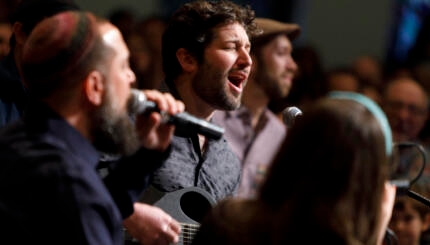San Francisco’s Mission District has its first new Jewish community in almost a decade. With the appearance of the Mission Minyan in 2005, the neighborhood has emerged as a bustling center of Jewish community for young adults in their 20s and 30s. In less than a year, the Mission Minyan grew from a small group that met in someone’s living room into a thriving community. Today, the Women’s Building, a multi-cultural community center in the area, hosts more than 120 young adults for volunteer-led Friday night services each week.
The emergence of this community is not unique to the early 21st century. In the 1960s and 1970s, young adults were similarly creating independent, lay-led prayer communities, which they called havurot. Initiated by baby boomers, then in their 20s and 30s, havurot were that generation’s effort to create Jewish communities that reflected their values and lifestyles.
Nor is this type of gathering unique to San Francisco. In the past decade, Jewish post-boomers (contemporary young adults in their 20s and 30s) have founded more than 48 independent minyanim across the U.S. They are located in cities of all sizes, from those with the largest Jewish populations like New York City, to those with smaller Jewish populations, like Denver and Phoenix. Because of their independence from mainstream Jewish institutions and lack of denominational affiliation, these communities have come to be called independent minyanim.
What Drives People to Pray?
To gain insight into this expression of Jewish identity and community, I conducted an ethnographic examination of the Mission Minyan. I added quantitative data to my study using sociologist Steven Cohen’s 2007 National Spiritual Communities Study, a survey of more than 800 participants in independent spiritual communities, which includes responses from 61 Mission Minyan participants.

Help us keep Jewish knowledge accessible to millions of people around the world.
Your donation to My Jewish Learning fuels endless journeys of Jewish discovery. With your help, My Jewish Learning can continue to provide nonstop opportunities for learning, connection and growth.
When examining the Mission Minyan in relation to other independent minyanim, a number of salient themes emerge, including the desire for authenticity, a focus on gender roles, and independence from the denominational movements. These themes also resonated in the havurah communities of the 1970s. Drawing a comparison between contemporary independent minyanim and havurot in decades past can highlight significant continuities and differences in the ways that young adults create Jewish identity and community.
In both havurot and independent minyanim, participants tended to be highly educated, Ashkenazic, heterosexual, middle class, and in their 20s and 30s. In both populations, participants had varying degrees of Jewish education and affiliation growing up. In both, individuals with the most Jewish education (or those with a strong desire to learn) emerged as core participants and leaders. Yet their access to Jewish education differed significantly. Since the 1970s, there has been a proliferation of Jewish educational opportunities in the U.S. to which women and girls have had unprecedented access. So both young men and women in independent minyanim have been exposed to more Jewish education than their counterparts in havurot.
The Aesthetics of the Prayer Service
Individuals in both groups were motivated by the desire to participate in prayer services they found personally meaningful. How that desire manifested in each group, however, was very different.
In her book Prayer and Community (1989), Riv-Ellen Prell describes how havurah participants engaged in a process of reflection about the meaning of the prayers in order to establish a personal connection with the service. They sometimes changed the traditional liturgy and incorporated the use of both English and Hebrew in an effort to make prayer relevant to their contemporary lives.
In contrast to havurot, most independent minyanim tend to conduct services with an emphasis on Hebrew. For many participants in independent minyanim, authenticity comes from a feeling of connection to history that is evoked through their use of traditional liturgy.
A Search for Meaning
While havurah participants brought relevance to their prayer by integrating contemporary music, art, and culture into the service, participants in independent minyanim integrate contemporary music of another sort. Many, including the Mission Minyan, use Hasidic-style melodies composed by Shlomo Carlebach, a 20th-century charismatic Orthodox rabbi and singer/songwriter. The incorporation of Hasidic-style music (however contemporary) is a way that participants further experience a connection to tradition.
Like members of havurot, participants in independent minyanim endeavor to incorporate their contemporary values into the service with regard to women’s roles. The Mission Minyan community employs various strategies to address participants’ both progressive and traditional ideals in terms of gender. Those participants who observe halakhah (Jewish law) require separate seating for men and women. For those who are uncomfortable with gender segregation, mixed seating is important. To address the differing needs of community members, the seating on Saturday mornings is arranged as a “tri-chitzah,” with a men’s section and a women’s section that are separated by mixed gender seating in the middle.
Other independent minyanim are also experimenting with this seating style, while others have a more traditional mechitzah, and still others have mixed seating. At havurot, mixed seating was the norm, reflecting their views about how to enact egalitarianism.
Counterculture/Subculture
Because it was purposely positioned outside of mainstream institutions, the havurah phenomenon was often referred to as the Jewish counterculture. Participants published books and articles criticizing American Judaism. They also spoke publically and even organized sit-in style protests, critiquing the Federation system for what they perceived as its imitation of Protestant, middle-class values.
Independent minyanim are not outside of the Jewish mainstream; they are on the margins of it. In fact, many independent minyanim have strong ties with Jewish institutions. Some receive funding from Jewish foundations, others gather in borrowed spaces in synagogues, and still others use scrolls loaned from area congregations.
Rather than the latest incarnation of a Jewish counterculture, independent minyanim represent a Jewish subculture. A subculture is a group that differentiates itself from the larger culture to which it belongs, while borrowing and transforming the symbols, values, and beliefs of that culture. Subcultures form as a collective solution to problems arising when a group of people feels that its position in the broader community is ambiguous.
In the case of participants in independent minyanim, most are in a lifecycle stage of emerging adulthood, a population that often feels underserved by existing Jewish institutions. They created their own communities to make a place for themselves where it did not previously exist.
Scholars and communal leaders have characterized the independent minyanim subculture as emergent, entrepreneurial, and innovative. Yet in a larger historical context, the phenomenon is far from unique. It is the most recent manifestation of a development that occurs in every age, as Jews find and create ways to congregate that reflect the particularities of their time and place. It seems that for every generation, everything old is new again.



